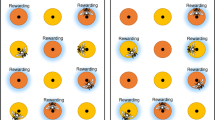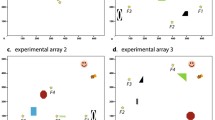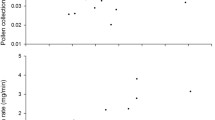Abstract
The temporal and spatial scales employed by foraging bees in sampling their environment and making foraging decisions should depend both on the limits of bumble bee memory and on the spatial and temporal pattern of rewards in the habitat. We analyzed data from previous experiments to determine how recent foraging experience by bumble bees affects their flight distances to subsequent flowers. A single visit to a flower as sufficient to affect the flight distance to the next flower. However, longer sequences of two or three visits had an additional effect on the subsequent flight distance of individual foragers. This suggests that bumble bees can integrate information from at least three flowers for making a subsequent foraging decision. The existence of memory for floral characteristics at least at this scale may have significance for floral selection in natural environments.
Similar content being viewed by others
References
Cresswell JE (1990) How and why do nectar-foraging bumblebees initiate movements between inflorescences of wild bergamot Monarda fistulosa (Lamiaceae). Oecologia 82:450–460
Dukas R, Real LA (1993) Effects of nectar variance on learning by bumble bees. Anim Behav 45:37–41
Gibson JJ (1966) The Senses Considered as Perceptual Systems. Houghton Publ., Boston
Heinrich B (1979) Resource hterogeneity and patterns of movements in foraging bumble bees. Oecologia 40:235–245
Levin DA (1978) The origin of isolating mechanisms in flowering plants. Evol Biol 11:185–317
Pleasants JM, Zimmerman M (1983) The distribution of standing crop of nectar: what does it really tell us? Oecologia 57:412–414
Real LA (1991) Animal choice behaviour and the evolution of cognitive architecture. Science 253:980–986
Real LA (1992) Information-processing and the evolutionary ecology of cognitive architecture. Am Nat
Real L, Rathcke BJ (1988) Patterns of individual variability in floral resources. Ecology 69:728–735
Southwick AK, EE Southwick EE (1983) Aging effect on nectar production in two clones of common milkweed, Asclepias syriaca. Oecologia 56:121–125
Tauber LR, Barnes DK (1979) Environmental and genetic influences on quantity and quality of alfalfa nectar. Crop Science 19:874–878
Waddington KD (1980) Flight patterns of foraging bees relative to density of artificial flowers and distribution of nectar. Oecologia 44:199–204
Waser NM, Mitchell RJ (1990) Nectar standing crops in Delphinium nelsonii flowers: spatial autocorrelation among plants? Ecology 71:116–123
Zimmerman M (1981) Patchiness in the dispersion of nectar resources: probable causes. Oecologia 49:154–157
Zimmerman M (1983) Plant reproduction and optimal foraging: environmental nectar manipulation in Delphinium nelsonii Oikos 41:57–63
Author information
Authors and Affiliations
Rights and permissions
About this article
Cite this article
Dukas, R., Real, L.A. Effects of recent experience on foraging decisions by bumble bees. Oecologia 94, 244–246 (1993). https://doi.org/10.1007/BF00341323
Received:
Accepted:
Issue Date:
DOI: https://doi.org/10.1007/BF00341323




